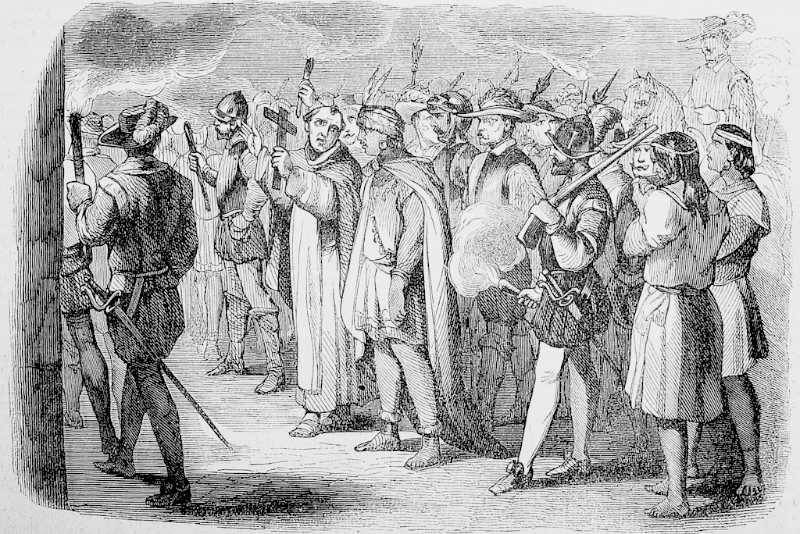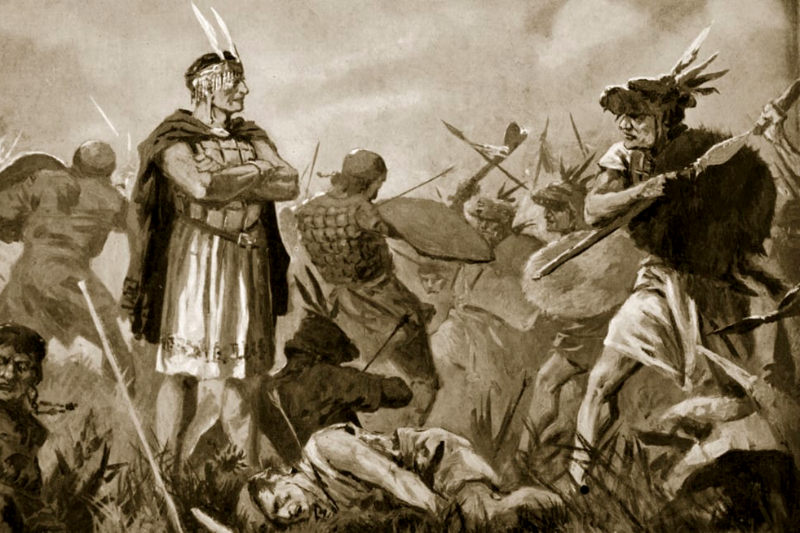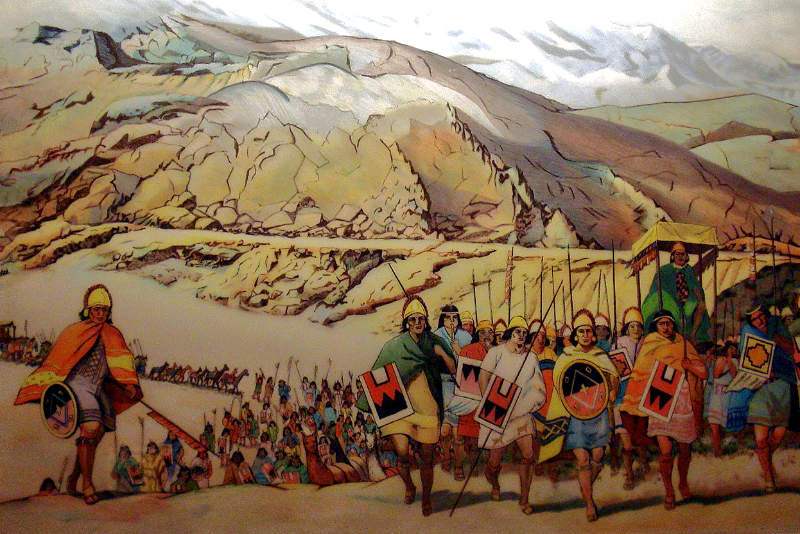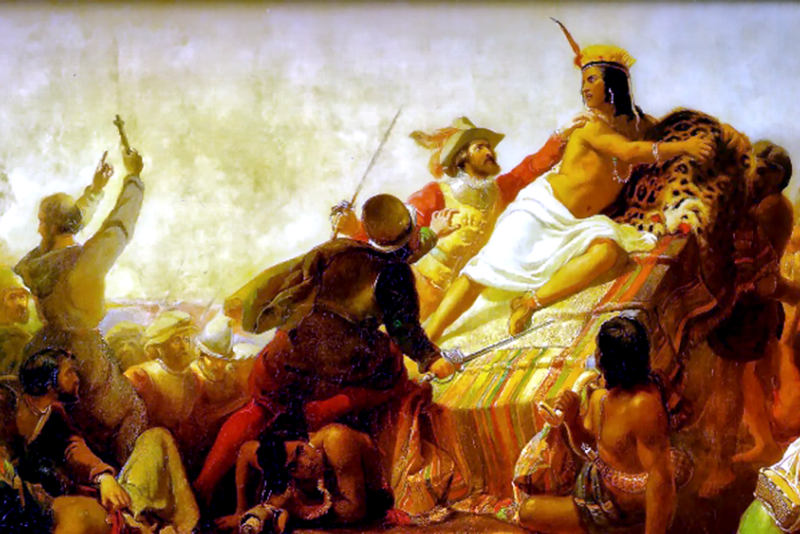Inca history: the civil war between Huáscar and Atahualpa
Between 1529 and 1533 the Incas lived through a bloody civil war that left around one million dead on both sides. Meanwhile, the Spaniards, led by Francisco Pizarro, arrived in Inca territory, making it easier for them to conquer together with other ethnic groups that were enemies of the Incas. The civil war was led by the successor brothers to the throne Huáscar and Atahualpa. Both would end up assassinated, without having returned to Cusco as rulers of the empire of the Tahuantinsuyo. In the following years, the Spaniards consolidated the conquest by entering Cusco and ruling the new order of the Viceroyalty of Peru.
- What was the Inca civil war?
- What were the consequences of the Inca civil war?
- The rescue of Atahualpa
- The Spanish conquest after the Inca civil war
- Questions and answers about the Inca civil war
The causes of the Spanish conquest in the great Incan empire
There were several causes of the Spanish conquest in the Inca territory, however, perhaps the most significant was the civil war between the brothers Huáscar and Atahualpa that took place at the beginning of the 16th century. This meant the weakening of the Inca population and their solid army, which suffered more than a million casualties. In addition, there were other decisive causes like the crucial support of the enemy ethnic groups of the Incas in favor of the Spaniards whom they saw as saviors or protectors (ethnic groups like the tallanes, the chimús, the chinchas, the yauyos, the cañaris, the chachapoyas, the chancas and the huancas. Another decisive reason for the balance to tip in favor of the Spaniards was the epidemic to the aboriginal population due to the new viruses and diseases that the Spaniards brought from Europe, such as influenza, typhus, mumps, diphtheria and syphilis. Likewise, the power of the Spanish army that carried firearms, horses for a more agile transport and metal swords favored the victory. One of the events that marked a before and after was the capture of the Inca Atahualpa, very significant in the Inca cosmovision. Finally, Francisco Pizarro devised a good plan of union and pacts with the Inca elite, which allowed him to reach the city of Cusco, capital of the empire.
What was the Inca civil war?
The Inca civil war was the dispute for power between the armies of the Huascar brothers (Cusco army) and Atahualpa (Quito army) for the Inca crown after the death of Emperor Huayna Capac in 1527 and his legitimate successor Nunan Cuyuchi (older brother of Huascar and Atahualpa) due to smallpox, probably a disease brought by the Spanish a few years earlier.
Before the Inca empire achieved its consolidation thanks to the governments of the emperors Pachacutec and his son and successor Túpac Yupanqui. Both achieved a dizzying expansion of the Inca territory after the decisive battle against the Chancas, as well as the expeditions to the north and south of the empire. Thus, the Inca empire expanded across vast regions of present-day Peru, Colombia, Ecuador, Bolivia, Chile and even Argentina.
Inca expansion continued under the rule of Emperor Huayna Capac. However, after his sudden death from smallpox, as well as the death of his son and successor in charge, the auqui Nunan Cuyuchi, the mascaipacha or Inca scepter was put on hold by the might of the armies of the generals and heir sons Huáscar and Atahualpa.
Huascar was the successor of Huayna Capac, so he received a good education in the city of Cusco, capital of the Inca empire, where he had a large army accustomed to the conquest expeditions. For the Inca elite, Huascar was the successor to Huayna Capac on the throne.
However, the general Atahualpa, a skillful strategist, had marched several years ago in conquest campaigns to the north, reaching the current city of Quito in Ecuador. Atahualpa also had a large and successful army who saw Atahualpa as their leader and successor to the throne of the Inca empire.
Thus, the Inca civil war also meant a rupture between the capital of the empire, the historic city of Cuzco, and the new and powerful city of Quito, where the victorious army in numerous battles settled.
Both brothers were skilled in warfare due to their military training. Both also craved the maximum power, destined to a single ruler. So Huascar acted first by inviting his brother to the city of Cusco to make a false peace. Atahualpa knew of the imminent danger that represented his presence in Cusco, it is this way that he/she sent emissaries who, as he/she calculated, were murdered by their brother’s army Huáscar.
This caused the battles of both armies in different places of the vast Inca empire. The first one in making his offensive for the north was Huáscar sending his brother Atoc. This one won in a first battle but was finally defeated in the battle of Mullihambato. It is said that his skull was covered in gold and used by Atahualpa as a token of his power. Huascar did not give up and sent another army led by the general Huanca Auqui who was also defeated in the battle of Tomebamba.
After a truce because of the harvest season in both sides, who undertook an offensive campaign this time was Atahualpa who from the town of Huamachuco sent his generals to Cusco. On the other hand, Huáscar himself led the decisive battle of Quipaipán where he was captured and taken prisoner by the general atahualpista Quizquiz.
The chronicles indicate that next the army of Atahualpa entered the city of Cusco giving horrible death to the royal family of Huáscar, as well as to his followers.
Meanwhile, in 1533, the Inca Atahualpa was imprisoned by the Spaniards in the city of Cajamarca. Huáscar, by orders of the prisoner Atahualpa, was taken towards Cajamarca half-naked, barefoot like one more prisoner. It is this way that before the fear that Francisco Pizarro supports in favor of his brother, Atahualpa orders his death throwing it to the Yanamayo river in the locality of Andamarca. Thus ends the Inca civil war that lasted approximately three years: between 1529 and 1533.
What were the consequences of the Inca civil war?
The civil war meant a rupture in the government of the Tahuantinsuyo when it was divided into a part of the empire in favor of Huáscar and another part in favor of Atahualpa.
Likewise, the most visible consequence was the thousands of deaths that occurred on both sides between 1529 and 1533, causing a great weakening of the, until a few years ago, solid Inca army. It is estimated that the casualties on both sides reached more than a million people.
As an example of how bloody the Inca civil war was, the Cusco chronicler Inca Garcilaso de la Vega states that around 150,000 people died in the battle at Hatun Xauxa alone.
Likewise, small towns and ethnic groups, mainly around the territories where the bloodiest battles took place, were abandoned. It is believed that the civil war between Huascar and Atahualpa was the cause of the abandonment of Machu Picchu.
Finally, the Inca civil war was a transcendental cause in the victory of the Spanish army and its arrival to Cusco putting an end to the Inca government. Ultimately the Spaniards would found the new economic order of colonialism in the new Viceroyalty of Peru.
The rescue of Atahualpa
The Inca civil war ended with the capture and death order of Huascar by Atahualpa whose victory did not last long because he was already imprisoned by Francisco Pizarro and the Spaniards in 1533. The rescue and death of Atahualpa was one of the most famous events in the history of the Incas.
Atahualpa was captured in 1532, in the middle of the civil war, while he was resting in the city of Cajamarca. The Spaniards planned their offensive very well, before a confident Atahualpa that triumphed in his campaigns against Huáscar.
On November 16, 1532, Atahualpa was captured in the Plaza de Armas of Cajamarca, after the murder of hundreds of people (it is estimated that the Spaniards killed around 3,000 people).
Holding the fearsome and powerful Atahualpa prisoner was key for Francisco Pizarro who devised a way to take advantage of his position and reach Cusco as the support of the nobles loyal to Huáscar (Atahualpa’s enemies). Finally, in spite of Pizarro’s promise to set him free in exchange for a ransom of hundreds of tons of gold and silver, the Inca was assassinated on July 26, 1533.
The Spanish conquest after the Inca civil war
After the Inca civil war and the death of Atahualpa, the Spaniards set out on their journey to Cusco, where they achieved the historic capture of Cusco on November 15, 1533.
For a safe capture Francisco Pizarro made alliances with curacas of various indigenous ethnic groups, as well as with the Inca nobility in Cusco, especially with the noble supporters or relatives of the assassinated Huáscar.
However, the Spaniards did not have an easy march to Cusco. First Pizarro named Túpac Hualpa, the brother of Atahualpa and Huáscar, as successor of the Inca mascaipacha. However, he was assassinated on the road to Cusco, presumably by a general in favor of Atahualpa.
In addition, in their march to Cusco, the Spaniards had to face other atahualpistas generals like Quizquiz in the regions of Vilcashuamán and Vilcaconga. To these battles the Spaniards were victorious due to the support of allied ethnic groups. Before arriving to the city of Cusco, Francisco Pizarro named Manco Inca as successor to the Inca throne. This one trusted in Pizarro for having defeated Atahualpa and for the promise to vindicate the rights of the Inca nobility in favor of Huáscar.
Finally the Spaniards arrived in Cusco supported by Manco Inca and the nobles of Cusco who soon realized the true intentions of Francisco Pizarro and his greed for gold and silver.
This is how Manco Inca rebelled and organized an army that withdrew to the jungle region of Vilcabamba from where they fought the Spaniards in Cusco. However, it was already very late because the Spaniards had a powerful army.

Spanish Conquest
Questions and answers about the Inca civil war
1) When was the Inca civil war fought and how long did it last?
The Inca civil war was fought between 1529 and 1533 and lasted approximately three years.
2) Who fought in the Inca civil war?
The Inca civil war confronted the army of Huáscar and Atahualpa, brothers and sons of the Inca Atahualpa.
3) How many people died in the Inca civil war?
It is estimated that as a result of the Inca civil war about 1 million people died on the sides of the armies of Huascar and Atahualpa.
4) Who was the winner in the Inca civil war?
Atahualpa’s army was the victor in the Inca civil war.
5) What were the causes of the Inca civil war?
The causes of the Inca civil war were the deaths of the Inca Huayna Capac and his heir to the throne Nunan Cuyuchi, leaving the Inca mascaipacha empty. To this is added the power of the armies of the brothers who disputed the throne: Huáscar and Atahualpa.
6) What were the consequences of the Inca civil war?
The Inca civil war caused more than a million deaths and the weakening of the Inca government and army. Ultimately this would facilitate the Spanish conquest.
7) How did the Spaniards take advantage of the Inca civil war?
The Spaniards took advantage of the weakening of the Inca army to march to Cusco and take the city for the subsequent imposition of the Viceroyalty of Peru.
8) Who was the loser of the Inca civil war?
Huascar’s army was the loser of the Inca civil war.
9) Where was the Inca civil war fought?
The Inca civil war was fought in the Inca empire, mainly in the northern regions of present-day Peru.
10) What was the result of the Inca civil war?
The result was the victory of Atahualpa’s army, whose victory was short-lived because he was captured and killed by the Spaniards who took advantage of this war to take Cusco and impose the new colonial government.
Advice from people who have been there
 By: Tatiana A.
By: Tatiana A.“Beautiful story“
“Cusco is full of stories that undoubtedly make it one of the most interesting places to visit in the world.“
By Ticket Machu Picchu – Last updated, October 18, 2024


